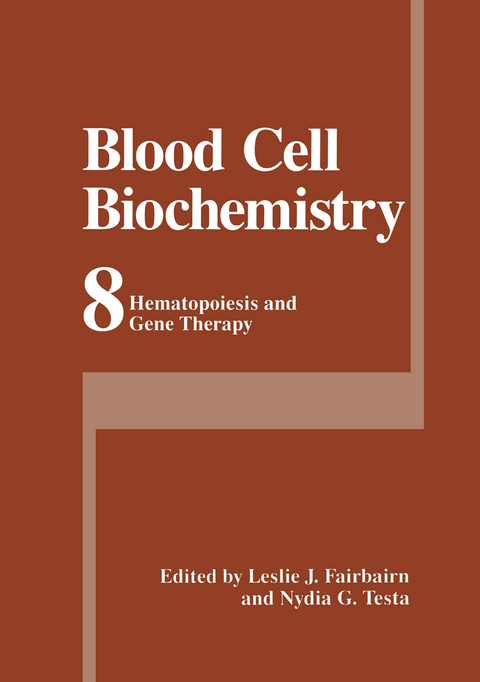
Blood Cell Biochemistry
Kluwer Academic/Plenum Publishers (Verlag)
978-0-306-45962-7 (ISBN)
1 Hemopoietic Stem Cells as Targets for Genetic Manipulation: Concepts and Practical Approaches.- 1. How Many Stem Cells Do We Need?.- 2. Selection and Identification by Phenotype and Function.- 3. Sources of Primitive Hematopoietic Cells.- 4. How Can We Maximize the Number of Target Cells?.- 5. Concluding Comments.- 6. References.- 2 Bone Marrow Transplantation for Genetic Diseases.- 1. Introduction.- 2. General Principles of BMT.- 3. The Bone Marrow Transplantation Process.- 4. Complications of BMT.- 5. Results of BMT.- 6. Future Directions.- 7. References.- 3 Retroviral Vectors.- 1. Why Retroviruses?.- 2. The Basic Vector.- 3. The Packaging Cell.- 4. References.- 4 Parvoviral Vectors for Human Hematopoietic Gene Therapy.- 1. Introduction.- 2. Life Cycle of Human Parvoviruses.- 3. Recombinant Parvoviral Vectors.- 4. Parvovirus-Mediated Transduction and Expression of Genes.- 5. Advantages and Disadvantages of Parvovirus Vectors.- 6. Summary and Conclusions.- 7. Future Prospects.- 8. References.- 5 Nonviral Methods for Gene Transfer.- 1. Introduction.- 2. Plasmid DNA-Based Methods.- 3. Artificial Self-Assembling Systems.- 4. References.- 6 Prospects for Gene Therapy of Inherited Immunodeficiency.- 1. Introduction to Gene Therapy.- 2. Immunodeficiency Disorders.- 3. Vector Systems and Their Suitability for Gene Therapy of Immunodeficiency.- 4. Gene Therapy for Immunodeficiency Disorders.- 5. Conclusion.- 6. References.- 7 Gene Therapy for Lysosomal Disorders.- 1. Defining a Population of Patients Suitable for Treatment.- 2. Gene Therapy.- 3. Targeting the Brain.- 4. Conclusions.- 5. References.- 8 Genetic Approaches to Therapy for the Hemoglobinopathies.- 1. Introduction.- 2. Current Therapies for ?-Thalassaemia.- 3. Current Therapies for Sickle Cell Disease.- 4.Regulation of Gene Expression from the Human ?-Globin Locus.- 5. Pharmaceutical Activation of Fetal ?-Globin Gene Expression in the Adult.- 6. Gene Therapy.- 7. Summary and Future Prospects.- 8. References.- 9 Gene Marking and the Biology of Hematopoietic Cell Transfer in Human Clinical Trials.- 1. Introduction.- 2. Gene Marking and Cancer Biology.- 3. Retroviral Marking of Tumor-Infiltrating Lymphocytes.- 4. Clinical Trials of Stem Cell Gene Marking.- 5. Clinical Trial Design.- 6. Retroviral Marking of Malignant Cells.- 7. Clinical Trial Results.- 8. Hematopoiesis and Gene Marking.- 9. Genetically Marked Relapse.- 10. Retroviral Gene Marking and Purging Efficacy.- 11. Implications of Gene Marking Results in Clinical Practice.- 12. In Vitro Strategies to Improve Hematopoietic Stem Cell Targeting.- 13. Future Directions.- 14. Summary.- 15. References.- 10 Antisense Strategies to Leukemia.- 1. Introduction.- 2. Antisense and Ribozymal Design and Mechanisms of Action.- 3. Controls, Experimental Systems, and Difficulties in Interpretation.- 4. Antisense and Ribozymes in Experimental Hematology.- 5. Clinical Trials in Hematology.- 6. Future Prospects.- 7. References.- 11 Transfer of Drug Resistance Genes into Bone Marrow Stem and Progenitor Cells: Implications for Cancer Chemotherapy.- 1. Introduction.- 2. Current Strategies for Hematopoietic Support during Chemotherapy.- 3. Gene Transfer, Expression, and Stem Cell Protection.- 4. Further Considerations.- 5. Concluding Remarks.- 6. References.- 12 HIV Gene Therapy Using Hairpin Ribozymes in Hematopoietic Stem/Progenitor Cells.- 1. Ribozyme for Gene Therapy of AIDS.- 2. Gene Therapy Using Hematopoietic Stem/Progenitor Cells.- 3. Transduction of Stem/Progenitor Cells Using Ribozymal Constructs.- 4. Toward Clinical Trials.-5. References.- 13 Molecular Immunotherapy by Gene Transfer.- 1. Introduction.- 2. Are Tumors Antigenic?.- 3. Antigen Presentation Pathways.- 4. Immunotherapy by Gene Transfer.- 5. Aims, Goals, and Targets for Gene Transfer in Immunotherapy.- 6. Unification of Diverse Results from Gene Transfer Studies.- 7. References.- 14 DNA-Based Immunization.- 1. Introduction.- 2. DNA Vaccines for Protection against Infectious Diseases.- 3. DNA Vaccines for Immunotherapy.- 4. Mechanism of Induction of Immune Responses.- 5. Safety Considerations.- 6. Summary and Future Directions.- 7. Implications for Gene Therapy.- 8. References.
| Erscheint lt. Verlag | 31.3.1999 |
|---|---|
| Reihe/Serie | Blood Cell Biochemistry ; 8 |
| Zusatzinfo | XVI, 380 p. |
| Verlagsort | New York |
| Sprache | englisch |
| Maße | 178 x 254 mm |
| Themenwelt | Medizinische Fachgebiete ► Innere Medizin ► Endokrinologie |
| Medizinische Fachgebiete ► Innere Medizin ► Hämatologie | |
| Medizin / Pharmazie ► Medizinische Fachgebiete ► Onkologie | |
| Studium ► 1. Studienabschnitt (Vorklinik) ► Biochemie / Molekularbiologie | |
| Studium ► 1. Studienabschnitt (Vorklinik) ► Histologie / Embryologie | |
| Studium ► 2. Studienabschnitt (Klinik) ► Humangenetik | |
| Naturwissenschaften ► Biologie ► Genetik / Molekularbiologie | |
| ISBN-10 | 0-306-45962-0 / 0306459620 |
| ISBN-13 | 978-0-306-45962-7 / 9780306459627 |
| Zustand | Neuware |
| Informationen gemäß Produktsicherheitsverordnung (GPSR) | |
| Haben Sie eine Frage zum Produkt? |
aus dem Bereich


